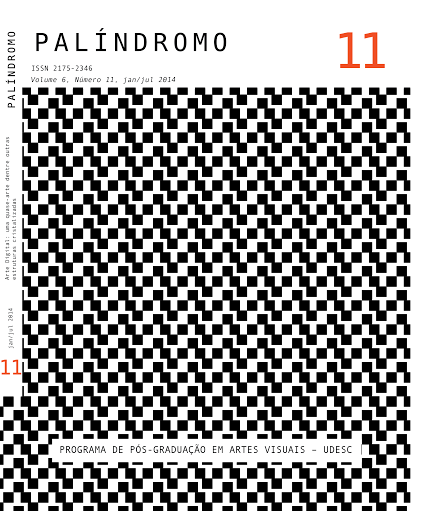A arte, o urbano e o social: um espaço de provocação
DOI:
https://doi.org/10.5965/2175234606112014064Palavras-chave:
arte , urbano , intervençãoResumo
Este artigo tem como objetivo propor considerações sobre os novos espaços ocupados pela arte e como essa pode interferir no espaço comum, no espaço urbano, criando uma rede de significações e reestruturando relações no meio urbano. A reorganização da sociedade contemporânea engloba também a reorganização dos espaços da arte, para exemplificar tais intervenções buscou-se destacar a obra de dois artistas que trabalham exclusivamente no espaço urbano, Jenny Holzer e Rafael Lozzano-Hemer. Diante de tais considerações busca-se visualizar como a arte comporta-se inserida no espaço das cidades, bem como inquirir outros arranjos de composições e fazeres que provoquem intensidades do viver.
Downloads
Referências
BAUMAN, Zygmunt Baumam. Modernidade Líquida. Rio de Janeiro: Jorge Zahr, 2001.
DELEUZE, Gilles. Foucault. Paris: Minuit, 1986. [Foucault.Trad. Bras. Claudia Sant’Anna Martins. São Paulo: Brasiliense, 1991]
______________. Spinoza: cours Vincennes. In: DELEUZE, G. Le cours de Gilles Deleuze. 13 jan. 1981. Disponível em: http://www.webdeleuze.com/php/liste_texte. php?groupe=Spinoza Acesso em: dez. 2012.
DIAS, RMS. Notas introdutórias de uma analítica no campo das modelizações voca- cionais. In JACÓ-VILELA, AM., CEREZZO, AC., and RODRIGUES, HBC., orgs. Clio-psyché: fazeres e dizeres psi na história do Brasil [online]. Rio de Janeiro: Centro Edels- tein de Pesquisas Sociais, 2012. p. 262-274. ISBN: 978-85-7982-061-8. Available from SciELO Books < http://books.scielo.org>.
______________. Foucault. São Paulo: Brasiliense, 2006.
DELEUZE, Gilles; GUATTARI, Félix. O anti-Édipo:capitalismo e esquizofrenia. Rio de Janeiro: Imago, 1976.
______________. Mil platôs: Capitalismo e esquizofrenia. Vol. 1. Rio de Janeiro: Editora 34, 1995.
______________. Mil Platôs: capitalismo e esquizofrenia. Vol. 2. Rio de Janeiro: Editora 34, 1995.
FOUCAULT, Michel. A ordem do discurso. Trad. de Laura Fraga de Almeida Sampaio. São Paulo: Loyola, 1996.
______________. Microfísica do Poder. 21 ed. Tradução Roberto Machado. Rio de Janeiro: Graal, 2006.
GALLO, Silvio. Deleuze & a Educação. Belo Horizonte: Autêntica, 2003.
HALL, Stuart. A identidade cultural na pós modernidade. Rio de Janeiro: DP&A, 2001.
HEMMER, Rafael L. Reflexiones em torno a cabos sueltos. Diálogo entre José Luis Barrios y Rafael Lozano Hemmer. In: Algunas cosas pasan más veces que todo el tempo. Espanha: Turner, 2007.
HOLZER, Jenny. Projections. Disponível em: <http://www.jennyholzer.com> Acesso em: set. 2014.
LOZANO-HEMMER, Rafael. Rafael Lozano Hemmer. Disponível em: <http://www.lozano-hemmer.com> Acesso em: set. 2014.
NASCIMENTO, E. Performar o discurso: teatro, travestismo, corpo-cidade. VIS: revista do PPG-Arte/UnB, Brasília, DF, v. 10, n. 1, p. 29-37, jan./jun. 2011.
PALLAMIN, Vera M. Arte Urbana: São Paulo Região Central (1945-1998): Obras de caráter temporário e permanente. São Paulo, Fapesp: 2000.
Downloads
Publicado
Como Citar
Edição
Seção
Licença
Copyright (c) 2014 Tatiana Palma Guerche, Andreia Machado Vieira

Este trabalho está licenciado sob uma licença Creative Commons Attribution 4.0 International License.
DECLARAÇÃO DE DIREITOS AUTORAIS
a. Os artigos publicados pela revista são de uso gratuito, destinados a aplicações acadêmicas e não comerciais. Todos os direitos autorais são atribuídos à revista. Os artigos cujos autores são identificados representam a expressão do ponto de vista de seus autores e não a posição oficial da Revista Palíndromo. O (s) autor (es) compromete-se sempre que publicar material referente ao artigo publicado no Palíndromo mencionar esta publicação da seguinte forma:
Este artigo foi publicado originalmente pela revista Palíndromo em seu volume (coloque o volume), número (coloque o número) no ano de (coloque o ano) e pode ser acessado em: http://www.revistas.udesc.br/index.php/palindromo
b. Plágio, em todas as suas formas, constitui um comportamento antiético de publicação e é inaceitável. A revista Palíndromo utiliza o software iThenticate de controle de similaridade


